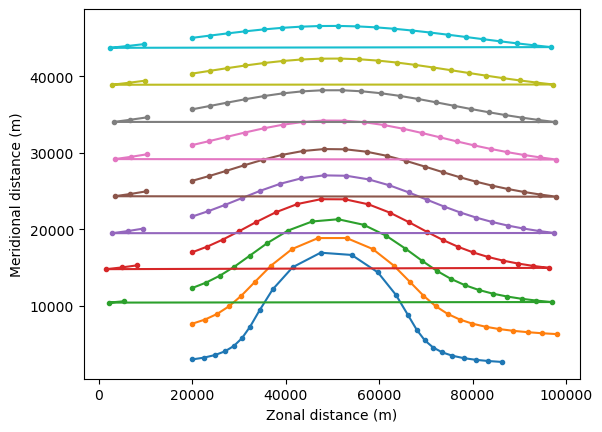Periodic boundaries#
This tutorial will show how to implement Periodic boundary conditions (where particles that leave the domain on one side enter again on the other side) can be implemented in Parcels
In case you have a global model on a C-grid, then there is typically not much that needs to be done. The only thing you have to be aware of, is that there is no ‘gap’ between the longitude values on the right side of the grid and on the left side of the grid (modulo 360). In other words, that
fieldset.U.lon[:, 0] >= fieldset.U.lon[:, -1]
This is the case for most curvilinear NEMO model outputs on a C-grid, so that periodic boundary conditions work out of the box, without any special code required.
For Hycom models, we have found that it can help to add an extra column of longitudes at the end of the longitude array:
lon_c = np.expand_dims(fieldset.U.grid.lon[:, 0], axis=1)
fieldset.U.grid.lon = np.hstack((fieldset.U.grid.lon, lon_c))
In case of ‘simple’ models on an A-grid, the idea in Parcels is to do two things:
Extend the fieldset with a small ‘halo’
Add a periodic boundary kernel to the
.execute
We’ll start by importing the relevant modules
[1]:
import math
from datetime import timedelta as delta
import matplotlib.pyplot as plt
import xarray as xr
from parcels import (
AdvectionRK4,
FieldSet,
JITParticle,
ParticleSet,
download_example_dataset,
)
We import the Peninsula fieldset; note that we need to set allow_time_extrapolation because the Peninsula fieldset has only one time snapshot.
[2]:
example_dataset_folder = download_example_dataset("Peninsula_data")
fieldset = FieldSet.from_parcels(
f"{example_dataset_folder}/peninsula", allow_time_extrapolation=True
)
Extending the fieldset with a halo is very simply done using the add_periodic_halo() method. Halos can be added either in the zonal direction, the meridional direction, or both, by setting zonal and/or meridional to True.
But before we apply the halo, we first define two new fieldset constants halo_east and halo_west. They store the original zonal extend of the grid (so before adding the halo) and will be used later in the periodicBC kernel.
Note that some hydrodynamic data, such as the global ORCA grid used in NEMO, already has a halo. In these cases, do not extent the fieldset with the halo but only add the periodic boundary kernel, where you use the explicit values for halo_east and halo_west
[3]:
fieldset.add_constant("halo_west", fieldset.U.grid.lon[0])
fieldset.add_constant("halo_east", fieldset.U.grid.lon[-1])
fieldset.add_periodic_halo(zonal=True)
The other item we need is a custom Kernel that can move the particle from one side of the domain to the other.
[4]:
def periodicBC(particle, fieldset, time):
if particle.lon < fieldset.halo_west:
particle_dlon += fieldset.halo_east - fieldset.halo_west
elif particle.lon > fieldset.halo_east:
particle_dlon -= fieldset.halo_east - fieldset.halo_west
Now define a particle set and execute it as usual
[5]:
pset = ParticleSet.from_line(
fieldset, pclass=JITParticle, size=10, start=(20e3, 3e3), finish=(20e3, 45e3)
)
output_file = pset.ParticleFile(name="PeriodicParticle", outputdt=delta(hours=1))
pset.execute(
[AdvectionRK4, periodicBC],
runtime=delta(hours=24),
dt=delta(minutes=5),
output_file=output_file,
)
INFO: Output files are stored in PeriodicParticle.zarr.
100%|██████████| 86400.0/86400.0 [00:00<00:00, 202338.06it/s]
And finally plot the particle trajectories
[6]:
ds = xr.open_zarr("PeriodicParticle.zarr")
plt.plot(ds.lon.T, ds.lat.T, ".-")
plt.xlabel("Zonal distance (m)")
plt.ylabel("Meridional distance (m)")
plt.show()

We can see that the particles start at 20,000m, move eastward, and once they hit the boundary at 90,000m, they jump to the other side of the domain (the horizontal lines). So we have periodic boundary conditions!
As a note, one may ask “why do we need the halo? Why can’t we use simply the PeriodicBC kernel?” This is because, if the particle is close to the edge of the fieldset (but still in it), AdvectionRK4 will need to interpolate velocities that may lay outside the fieldset domain. With the halo, we make sure AdvectionRK4 can access these values.
